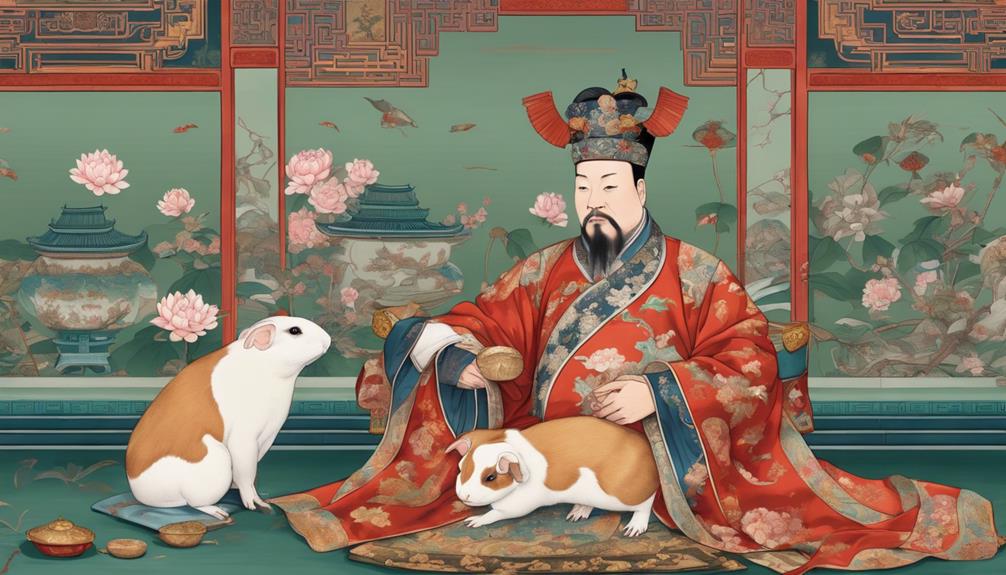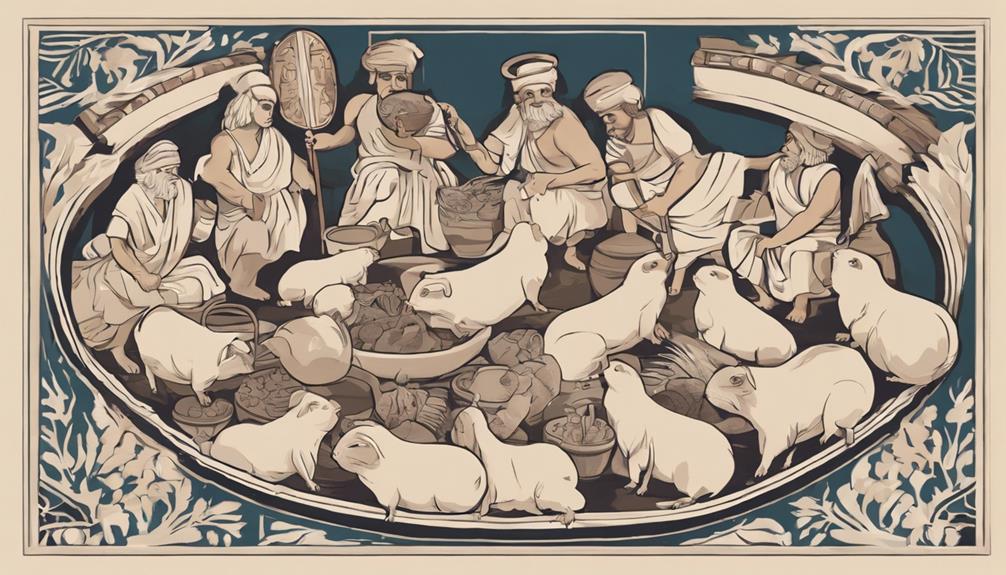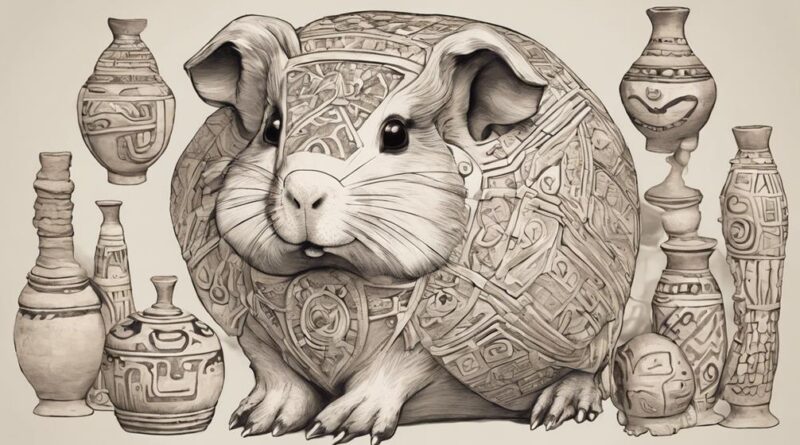Ancient Civilizations' Fascinating Relationship With Guinea Pigs
When exploring ancient civilizations, you'll find a surprising common thread – the fascinating relationship they had with guinea pigs. From the Andean cultures to Egyptian society, and Roman times to Chinese civilization, these small creatures played varied roles that often revealed deeper insights into the daily lives and beliefs of these societies.
As you delve into the historical accounts of guinea pigs in different ancient civilizations, you'll uncover a world where these animals held significance beyond mere companionship or sustenance, offering a glimpse into the cultural values and practices of the past.
Origins of Guinea Pigs
Where did guinea pigs originally come from and how did they become domesticated pets?
Guinea pigs have fascinating evolutionary origins that trace back to the Andes mountains in South America. These small rodents, scientifically known as Cavia porcellus, are believed to have been domesticated by ancient civilizations such as the Inca around 5,000 to 7,000 years ago. It's thought that guinea pigs were initially domesticated for their meat, which was a valuable food source for these early cultures.
The domestication process of guinea pigs was likely a gradual one. Initially, they were kept and bred by ancient Andean peoples for sustenance. Over time, these animals became more than just a food source; they also played important roles in religious ceremonies and traditional medicine. Through selective breeding, guinea pigs started to exhibit a variety of coat colors and patterns, leading to the diverse breeds we see today.
As these civilizations expanded and interacted with other cultures, guinea pigs spread beyond the Andean region. Spanish explorers later introduced them to Europe, where they gained popularity as exotic pets among the nobility. Eventually, guinea pigs made their way to other parts of the world through trade and exploration, solidifying their place as beloved household pets with a rich history rooted in ancient traditions.
Guinea Pigs in Andean Culture
Ancient Andean civilizations deeply integrated guinea pigs into their culture, utilizing them not only as a food source but also in religious ceremonies and traditional medicine. Incan traditions held guinea pigs in high esteem, considering them sacred animals. These small creatures played a significant role in Andean rituals, symbolizing abundance, fertility, and sacrifice.
In Incan society, guinea pigs were often used in religious ceremonies as offerings to the gods. They were believed to bridge the spiritual and earthly realms, acting as intermediaries between humans and the divine. The sacrifice of guinea pigs was seen as a way to communicate with the gods and seek their blessings for a successful harvest or important events.
Moreover, guinea pigs were also utilized in traditional medicine by Andean healers. Their fur, bones, and even their feces were believed to have curative properties. Incan healers would use various parts of the guinea pig in medicinal concoctions to treat ailments and promote healing.
Guinea Pigs in Egyptian Society
Guinea pigs were significant animals in Egyptian society, playing various roles beyond just being pets. In ancient Egypt, these small creatures held a special place in religious practices and daily life. They were commonly used in Egyptian rituals, often offered as sacrifices to honor the gods. Guinea pig offerings were believed to bring blessings and protection to the people making the offerings.
Moreover, guinea pigs held symbolism in Egyptian art, appearing in various depictions and hieroglyphics. These representations showcased the importance of guinea pigs in Egyptian culture and their association with fertility, abundance, and prosperity. The presence of guinea pigs in Egyptian art served as a reminder of their significance in both the spiritual and earthly realms.
The Egyptians' reverence for guinea pigs extended beyond their practical uses as offerings or artistic symbols. These animals were also kept as pets by many Egyptians, providing companionship and joy to both children and adults alike. The presence of guinea pigs in Egyptian society was a testament to the deep-rooted connection between humans and these beloved creatures during that ancient era.
Guinea Pigs in Roman Times
During the height of the Roman Empire, these small rodents played a significant role in various aspects of society, reflecting both practical and symbolic meanings. Guinea pigs weren't only kept as Roman pets but were also considered exotic companions, often found in the homes of the elite and nobility.
In Roman times, guinea pigs were cherished for their adorable appearance and gentle demeanor. They were kept as household pets, providing companionship and entertainment to their owners. These furry creatures were especially popular among children, who delighted in their playful antics and affectionate nature.
Beyond being valued as Roman pets, guinea pigs held symbolic significance in Roman society. They were associated with concepts of abundance, fertility, and good fortune. It was believed that having a guinea pig in the home could bring luck and prosperity to the household, making them highly sought after as exotic companions.
In addition to their symbolic meanings, guinea pigs also served practical purposes in Roman times. They were sometimes used in religious ceremonies and rituals, representing purity and innocence. Their presence added a touch of charm and whimsy to various social gatherings and events, further solidifying their place in Roman society as beloved and cherished creatures.
Guinea Pigs in Chinese Civilization

Highly regarded in Chinese civilization, guinea pigs played diverse roles beyond mere companionship, reflecting both practical utility and symbolic significance. In Chinese traditions, guinea pigs were valued for their practical uses in various aspects of daily life. They were commonly kept as pets by aristocrats and nobles, admired for their gentle nature and cute appearance. Additionally, guinea pigs were utilized in traditional Chinese medicine for their supposed healing properties. Their droppings were believed to have medicinal benefits, and their presence was thought to bring good luck and positive energy to households.
Moreover, guinea pigs held symbolic significance in Chinese culture. They were often associated with abundance, wealth, and prosperity. In Feng Shui practices, the guinea pig symbol represented fertility and financial success. People would place figurines or images of guinea pigs in their homes or workplaces to attract good fortune. The guinea pig's round body and cute features were seen as auspicious symbols that brought happiness and harmony to the environment.
In Chinese art and literature, guinea pigs were frequently depicted to convey positive themes such as harmony, family unity, and longevity. Their presence in various cultural expressions underscored their enduring significance in Chinese society, where they were more than just pets but symbols of prosperity and well-being.
Guinea Pigs in Pre-Columbian Cultures
In the ancient civilizations predating the arrival of Europeans in the Americas, the cultural significance of guinea pigs was profound, showcasing their multifaceted roles beyond mere pets. Guinea pigs held a central place in pre-Columbian cultures, intertwined with spiritual beliefs and used in sacrificial ceremonies. These small animals were considered sacred in many societies, believed to possess mystical qualities and serve as a link between the earthly realm and the spiritual world.
Moreover, guinea pigs played a crucial role in the agricultural practices of pre-Columbian civilizations. They weren't only a vital food source but also instrumental in enhancing agricultural productivity through their droppings, which were used as fertilizer. Breeding techniques were carefully honed to ensure the availability of guinea pigs for various purposes, including religious ceremonies and everyday sustenance. Their ability to reproduce quickly and in large numbers made them a valuable asset in sustaining communities.
The close relationship between guinea pigs and pre-Columbian cultures underscores the intricate ways in which these animals were integrated into daily life. From spiritual beliefs and sacrificial rituals to agricultural practices and breeding techniques, guinea pigs held a position of significance that went beyond their physical presence, shaping the cultural landscape of ancient civilizations in the Americas.
Guinea Pigs in Greek History

Guinea pigs featured prominently in the historical accounts of ancient Greece, revealing their diverse roles in the society of that era. In Greek mythology, these small creatures were often associated with the goddess Artemis, who was believed to keep them as companions. Their gentle nature and cute appearance made them a symbol of fertility and motherhood in various Greek myths.
Moreover, guinea pigs played a significant role in scientific research in ancient Greece. Scholars like Aristotle documented detailed observations of these animals, laying the foundation for early zoological studies. Their docile behavior and reproductive patterns fascinated Greek naturalists, contributing to the broader understanding of biology during that time.
Greek philosophers also found guinea pigs to be intriguing subjects for philosophical inquiry. The Stoics, for instance, admired the simplicity and contentment exhibited by these creatures, using them as symbols of living in harmony with nature and accepting one's circumstances.
Guinea Pigs in Mesopotamia
Mesopotamian society regarded guinea pigs as sacred companions to their deities, reflecting a deep cultural reverence for these animals. These small creatures played significant roles in Mesopotamian life, serving not only as beloved pets but also as symbols of various aspects of their society.
Here are three key ways guinea pigs were integral to Mesopotamian culture:
- Mesopotamian Pets: Guinea pigs were cherished as pets by the Mesopotamians, who valued their gentle nature and sociable behavior. These animals were often kept in homes and temples, where they roamed freely and were well cared for by the people. Mesopotamian families developed strong bonds with their guinea pigs, considering them part of the household and treating them with great affection.
- Guinea Pig Symbolism: In Mesopotamia, guinea pigs held symbolic significance in religious and cultural practices. They were associated with fertility, abundance, and prosperity, and were sometimes used in rituals to invoke blessings from the gods. The presence of guinea pigs in ceremonies and artwork symbolized the interconnectedness of the physical and spiritual worlds in Mesopotamian belief systems.
- Cultural Importance: Guinea pigs weren't just seen as ordinary animals in Mesopotamia; they were elevated to a position of cultural importance. Their presence in everyday life and religious ceremonies highlighted the deep respect and admiration that the Mesopotamians had for these small creatures, showcasing the unique bond between humans and guinea pigs in this ancient civilization.
Frequently Asked Questions
Are There Any Myths or Legends Surrounding Guinea Pigs in Ancient Civilizations?
When it comes to myths or legends surrounding guinea pigs in ancient civilizations, there's a rich tapestry of stories to explore. These tales often delve into the mythical origins of guinea pigs and their cultural significance.
In various ancient cultures, guinea pigs were believed to possess magical qualities and were sometimes even associated with deities or spiritual beings. Their presence in these stories highlights the deep-rooted connection between humans and these adorable creatures.
Did Ancient Civilizations Use Guinea Pigs for Any Medicinal or Ritualistic Purposes?
In ancient civilizations, guinea pigs were valued for their medicinal uses and played a role in ritualistic practices. People believed in the healing properties of guinea pigs and used them in remedies for various ailments.
Additionally, these small animals were included in sacred rituals and ceremonies as offerings or symbols of luck and prosperity. Guinea pigs were an integral part of both the medical and spiritual aspects of ancient societies.
How Did the Diet of Guinea Pigs in Ancient Civilizations Differ From Their Diet Today?
In ancient civilizations, guinea pigs were fed a diet primarily of fresh vegetables and grains. This dietary evolution was significant as it reflected cultural practices and beliefs. Historical consumption of guinea pigs was based on their availability and nutritional value.
Today, modern practices emphasize a balanced diet that includes hay, fresh vegetables, and pellets. The shift from ancient diets to current recommendations highlights how attitudes towards guinea pig nutrition have changed over time.
Were Guinea Pigs Ever Used as Currency or Traded in Ancient Civilizations?
Yes, in some ancient civilizations, guinea pigs were indeed used as currency or traded.
Bartering guinea pigs was common practice, and they held value for various reasons. Guinea pig trade was significant for these societies, as these animals weren't only a source of food but also had cultural and ritualistic importance.
Their versatility made them a valuable commodity in exchanges and transactions within these communities.
Did Ancient Civilizations Have Any Specific Beliefs or Superstitions Regarding Guinea Pigs?
In ancient civilizations, beliefs about guinea pigs varied widely. Some cultures viewed them as symbols of abundance and fertility, incorporating them into rituals and ceremonies. Others considered them bad omens and avoided them altogether.
Superstitions surrounding guinea pigs often influenced practices related to agriculture and family life. Folklore attributed mystical powers to these animals, shaping how they were perceived and treated within different societies.
Conclusion
In conclusion, guinea pigs played a significant role in various ancient civilizations, serving as a source of food, companionship, and even religious significance.
From the Andean cultures to Egyptian society, Roman times to Chinese civilization, and Greek history to Mesopotamia, guinea pigs were valued and revered by these societies.
Their unique relationship with humans showcases the importance of these small creatures throughout history.
